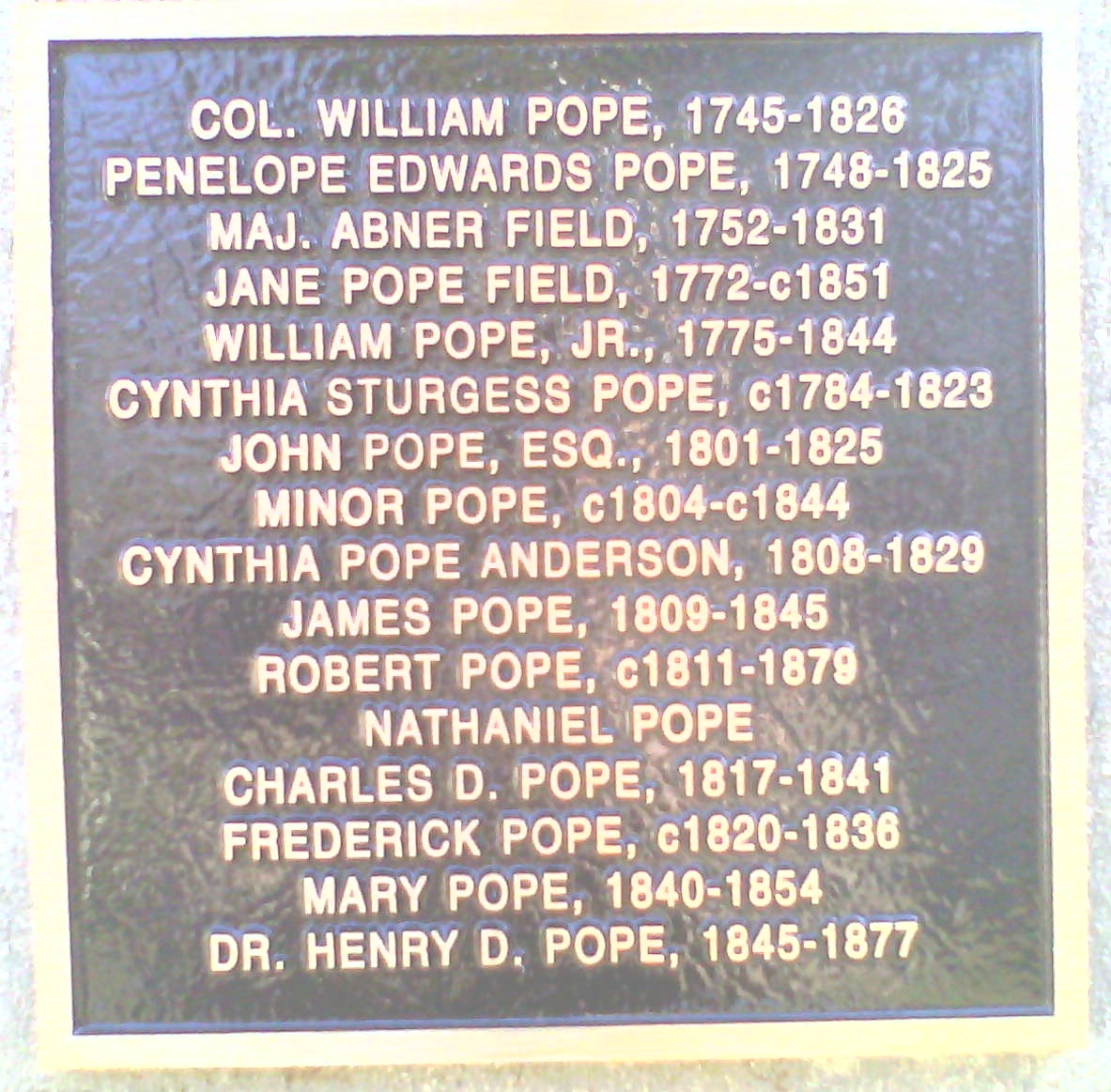It was once thought that the Early Italianate-style mansion at 1835 Hampden Court was built by Pope. The Courier-Journal & Times, February 29, 1976, Magazine, 12. But there is no evidence any part of the house dates before 1850. The Hampden Court property was included in a tract of 23 acres sold in 1848 by William H. Pope and Larz Anderson for $4,000 which amount would not likely include a house. Jefferson County, Ky. Deed Book 69, page 406. William Pope, Jr. sold 102 acres and “incumbrances [probably house]”to Justice McKinley for $20,500. Jefferson County, Ky. Deed Book 50, page 525.
Pope subsequently bought 950 acres, extending from the Ohio River to Longest Place and Cherokee Park. He married in 1800, Cynthia Ann Sturgess (1783/5-1823), daughter of James A. Sturgess. They had ten children. The following lived to become of age and married, John (1801-25), William H. (1803-67), Robert (c1811-79), Capt. Godfrey (-1846), Cynthia Ann (1808-30), and Charles Donald Pope (1817-41). The others were Nathaniel, Minor (c1802-c44), James (1809-45), and Frederick Pope (c1820-36). The Filson Historical Society has a painting of James Pope.
William Pope, Jr. and his wife were buried in the Pope family cemetery next to 2134 Edgehill Road. In 1920 there was still standing a handsome monument to mark their graves. The stone cemetery wall was subsequently removed and the only monument remaining in 2014 was an obelisk marking the graves of Elizabeth Campbell (1815-42) and her four children who died in 1842 during an epidemic. She was probably a daughter of Justice McKinley who owned the cemetery from 1838-49 when she died. In 1877 daughter Kate Pope and in 1881 Kate's parents and three other children were removed from the Pope family cemetery to Cave Hill Cemetery. In 2014-15, all the remains contained in the Pope cemetery and the Campbell obelisk were removed to the Kate Pope lot in Cave Hill Cemetery by archaeologist Jay Stottman through the efforts of James Houston Barr III. Elizabeth Campbell’s husband may have been Donald Campbell who was a broker- merchandiser.
See Will of William Pope, Jr., 3 Will Book 370, Jefferson County, Ky.; Jefferson County, Ky. Deed Book 50, page 525 (Pope to McKinley); 72 DB 395 (McKinley to McKinley); J. Stoddard Johnston, Memorial History of Louisville From Its First Settlement To The Year 1896 (Chicago & New York, 1896), II: 646; George W. Beale, "Col. Nathaniel Pope and His Descendants," William & Mary College Quarterly XII: 192-196, 250-253 (1903-1904); Kathleen Jennings, Louisville's First Families (Louisville, 1920), 72; James Houston Barr III, Lt. Colonel Nathaniel Pope, c1610-1660, of Virginia, Ancestor of Washington, Governors and Legislators, History of His Descendants (Louisville, Ky. 2018), 360-365.
It was once thought that the Early Italianate-style mansion at 1835 Hampden Court was built by Pope. The Courier-Journal & Times, February 29, 1976, Magazine, 12. But there is no evidence any part of the house dates before 1850. The Hampden Court property was included in a tract of 23 acres sold in 1848 by William H. Pope and Larz Anderson for $4,000 which amount would not likely include a house. Jefferson County, Ky. Deed Book 69, page 406. William Pope, Jr. sold 102 acres and “incumbrances [probably house]”to Justice McKinley for $20,500. Jefferson County, Ky. Deed Book 50, page 525.
Pope subsequently bought 950 acres, extending from the Ohio River to Longest Place and Cherokee Park. He married in 1800, Cynthia Ann Sturgess (1783/5-1823), daughter of James A. Sturgess. They had ten children. The following lived to become of age and married, John (1801-25), William H. (1803-67), Robert (c1811-79), Capt. Godfrey (-1846), Cynthia Ann (1808-30), and Charles Donald Pope (1817-41). The others were Nathaniel, Minor (c1802-c44), James (1809-45), and Frederick Pope (c1820-36). The Filson Historical Society has a painting of James Pope.
William Pope, Jr. and his wife were buried in the Pope family cemetery next to 2134 Edgehill Road. In 1920 there was still standing a handsome monument to mark their graves. The stone cemetery wall was subsequently removed and the only monument remaining in 2014 was an obelisk marking the graves of Elizabeth Campbell (1815-42) and her four children who died in 1842 during an epidemic. She was probably a daughter of Justice McKinley who owned the cemetery from 1838-49 when she died. In 1877 daughter Kate Pope and in 1881 Kate's parents and three other children were removed from the Pope family cemetery to Cave Hill Cemetery. In 2014-15, all the remains contained in the Pope cemetery and the Campbell obelisk were removed to the Kate Pope lot in Cave Hill Cemetery by archaeologist Jay Stottman through the efforts of James Houston Barr III. Elizabeth Campbell’s husband may have been Donald Campbell who was a broker- merchandiser.
See Will of William Pope, Jr., 3 Will Book 370, Jefferson County, Ky.; Jefferson County, Ky. Deed Book 50, page 525 (Pope to McKinley); 72 DB 395 (McKinley to McKinley); J. Stoddard Johnston, Memorial History of Louisville From Its First Settlement To The Year 1896 (Chicago & New York, 1896), II: 646; George W. Beale, "Col. Nathaniel Pope and His Descendants," William & Mary College Quarterly XII: 192-196, 250-253 (1903-1904); Kathleen Jennings, Louisville's First Families (Louisville, 1920), 72; James Houston Barr III, Lt. Colonel Nathaniel Pope, c1610-1660, of Virginia, Ancestor of Washington, Governors and Legislators, History of His Descendants (Louisville, Ky. 2018), 360-365.
Family Members
Advertisement
Records on Ancestry
Advertisement

















